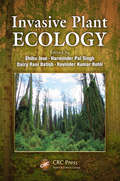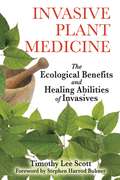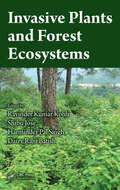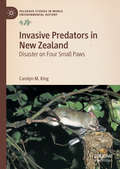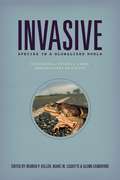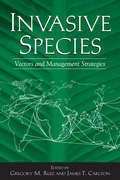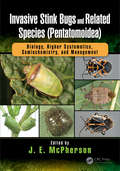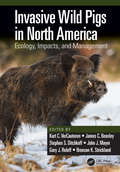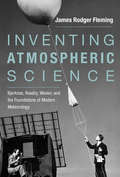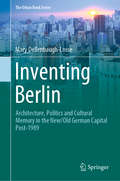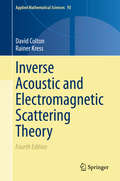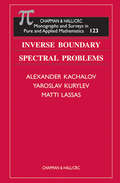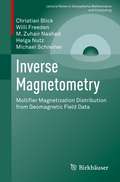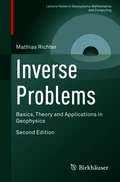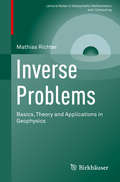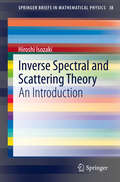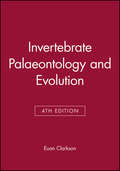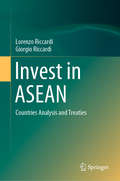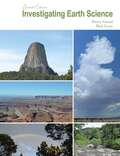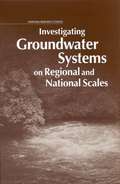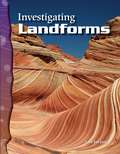- Table View
- List View
Invasive Plant Ecology
by Shibu Jose Ravinder Kumar Kohli Harminder Pal Singh Daizy Rani BatishInvasion of non-native plant species, which has a significant impact on the earth's ecosystems, has greatly increased in recent years due to expanding trade and transport among different countries. Understanding the ecological principles underlying the invasive process as well as the characteristics of the invasive plants is crucial for making good
Invasive Plant Medicine: The Ecological Benefits and Healing Abilities of Invasives
by Stephen Harrod Buhner Timothy Lee ScottThe first book to demonstrate how plants originally considered harmful to the environment actually restore Earth’s ecosystems and possess powerful healing properties • Explains how invasive plants enhance biodiversity, purify ecosystems, and revitalize the land • Provides a detailed look at the healing properties of 25 of the most common invasive plants Most of the invasive plant species under attack for disruption of local ecosystems in the United States are from Asia, where they play an important role in traditional healing. In opposition to the loud chorus of those clamoring for the eradication of all these plants that, to the casual observer, appear to be a threat to native flora, Timothy Scott shows how these opportunistic plants are restoring health to Earth’s ecosystems. Far less a threat to the environment than the cocktails of toxic pesticides used to control them, these invasive plants perform an essential ecological function that serves to heal both the land on which they grow and the human beings who live upon it. These plants remove toxic residues in the soil, providing detoxification properties that can help heal individuals. Invasive Plant Medicine demonstrates how these “invasives” restore natural balance and biodiversity to the environment and examines the powerful healing properties offered by 25 of the most common invasive plants growing in North America and Europe. Each plant examined includes a detailed description of its physiological actions and uses in traditional healing practices; tips on harvesting, preparation, and dosage; contraindications; and any possible side effects. This is the first book to explore invasive plants not only for their profound medical benefits but also with a deep ecological perspective that reveals how plant intelligence allows them to flourish wherever they grow.
Invasive Plants and Forest Ecosystems
by Shibu Jose Ravinder Kumar Kohli Harminder Pal Singh Daizy Rani BatishAs the worldwide human population explodes and trade becomes increasingly globalized, the transboundary movement of plant species from their place of origin to foreign regions is escalating and expected to experience continued growth in the coming decades. Invasive non-native species pose one of the greatest challenges for natural resource managers who are charged with the maintenance of biological diversity and the sustainable production of forest resources. With international contributors presenting an informed and integrated approach to the control of havoc-wrecking species, Invasive Plants and Forest Ecosystems provides the most updated information on invading plants, their impacts on forest ecosystems, and control strategies. This text addresses such important issues as the socioeconomic and policy aspects of plant invasion and offers complete coverage of their ecological impacts and the varied levels of threats in diverse situations.
Invasive Predators in New Zealand: Disaster on Four Small Paws (Palgrave Studies in World Environmental History)
by Carolyn M. KingThe story of invasive species in New Zealand is unlike any other in the world. By the mid-thirteenth century, the main islands of the country were the last large landmasses on Earth to remain uninhabited by humans, or any other land mammals. New Zealand’s endemic fauna evolved in isolation until first Polynesians, and then Europeans, arrived with a host of companion animals such as rats and cats in tow. Well-equipped with teeth and claws, these small furry mammals, along with the later arrival of stoats and ferrets, have devastated the fragile populations of unique birds, lizards and insects. Carolyn M. King brings together the necessary historical analysis and recent ecological research to understand this long, slow tragedy. As a comprehensive historical perspective on the fate of an iconic endemic fauna, this book offers much-needed insight into one of New Zealand’s longest-running national crises.
Invasive Species and Global Climate Change (CABI Invasives Series)
by Lewis H. ZiskaThis book addresses topics related to the impact of invasive species including biosecurity, demographics, species diversity and food security. It is meant for researchers, upper-level students, and policy makers and provides a factual basis for the underlying science and a discussion of that information with respect to current and future impacts and possible solutions. This book explores the nexus of climate change and biological invasions, resulting impacts (biological and economic) and assesses ways to reduce vulnerability and increase the resiliency and sustainability of managed and unmanaged ecosystems. The book has three parts, focusing on: (1) the dimensions of the problem; background and science; (2) case studies; (3) Management: detection, prevention, control and adaptation. This revised edition examines a wide range of topics and region, the underlying science, examples (case studies) from around the world, and ways and means to recognize, manage and control the consequences. It includes new cases and new threats; for example, a chapter summarizing case studies regarding climate change and invasive species that are also disease carriers (e.g. ticks and Lyme disease). - Covers a wide range of topics and areas - Examines the synergy between invasive species and climate change - Explains options to control and mitigate effects This book is of interest to academics, researchers and students studying climate change and invasive species. Those interested in the environment and ecology, land managers, policy makers, agronomists, federal and state departments of natural resources, climate change activists, public health professionals.
Invasive Species in a Globalized World: Ecological, Social, & Legal Perspectives on Policy
by Reuben P. Keller, Marc W. Cadotte, Glenn SandifordOver the past several decades, the field of invasion biology has rapidly expanded as global trade and the spread of human populations have increasingly carried animal and plant species across natural barriers that have kept them ecologically separated for millions of years. Because some of these nonnative species thrive in their new homes and harm environments, economies, and human health, the prevention and management of invasive species has become a major policy goal from local to international levels. Yet even though ecological research has led to public conversation and policy recommendations, those recommendations have frequently been ignored, and the efforts to counter invasive species have been largely unsuccessful. Recognizing the need to engage experts across the life, social, and legal sciences as well as the humanities, the editors of this volume have drawn together a wide variety of ecologists, historians, economists, legal scholars, policy makers, and communications scholars, to facilitate a dialogue among these disciplines and understand fully the invasive species phenomenon. Aided by case studies of well-known invasives such as the cane toad of Australia and the emerald ash borer, Asian carp, and sea lampreys that threaten US ecosystems, Invasive Species in a Globalized World offers strategies for developing and implementing anti-invasive policies designed to stop their introduction and spread, and to limit their effects.
Invasive Species: Vectors and Management Strategies
by Gregory M. Ruiz James CarltonInvasive Species brings together in a single volume new information from leading scientists around the world on approaches to controlling and managing invasion vectors. This volume is a timely and essential reference for scientists, researchers, policymakers, and anyone concerned with understanding biological invasions and developing effective responses to them.
Invasive Stink Bugs and Related Species: Biology, Higher Systematics, Semiochemistry, and Management (Contemporary Topics in Entomology)
by J. E. McPhersonKey features: Presents a brief history of past classifications, a summary of present classification, and speculation on how the classification may evolve in the future Includes keys for the identification of families and subfamilies of the Pentatomoidea and for the tribes in the Pentatomidae Explains transmission of plant pathogens and concepts of pathology and heteropteran feeding for the non-specialist Provides an extensive literature review of transmission by stink bugs of viral, bacterial, fungal, and protozoan organisms that cause diseases of plants Discusses the diversity of microbial symbionts in the Pentatomidae and related species, showing how microorganisms underpin the evolution of this insect group Reviews semiochemicals (pheromones, kairomones, allomones) of the Pentatomoidea and their vital role in the life histories of pest and beneficial species and their exploitation by natural enemies of true bugs Covers past, current, and future control options for insects, with a focus on stink bugs and related heteropterans The Superfamily Pentatomoidea (stink bugs and their relatives) is comprised of 18 families with over 8,000 species, the largest of which is the family Pentatomidae (about 5,000 species). These species primarily are phytophagous, and many cause tremendous economic damage to crops worldwide. Within this superfamily are six invasive species, two that occur worldwide and four that are recent invaders in North America. Once established in new geographic regions, these species have increased their numbers and geographic distributions dramatically, causing economic damage totaling billions of dollars. Invasive Stink Bugs and Related Species (Pentatomoidea): Biology, Higher Systematics, Semiochemistry, and Management is the first book that presents comprehensive coverage of the biology of invasive pentatomoids and related true bug species and addresses issues of rapidly growing economic and environmental concerns. Containing the contributions of more than 60 stink bug specialists from 15 countries, this book provides a better understanding of the biology and economic importance of these invasive species, why they became invasive, and how their continued geographical expansion is likely to affect numerous agricultural systems and natural environments. Including over 3,500 references, this authoritative work serves as an access point to the primary literature on their life histories, higher systematics, diapause and seasonal cycles, pathogens, symbionts, semiochemistry, and pest management control strategies for pentatomoid bugs.
Invasive Wild Pigs in North America: Ecology, Impacts, and Management
by Kurt C. VerCauteren James C. Beasley Stephen S. Ditchkoff John J. Mayer Gary J. Roloff Bronson K. StricklandThroughout North America, non-native wild pigs have become an ecologically and economically destructive invasive species. Though they are regarded as a popular game species by some, provide economic benefits to others, and are even engrained into societal heritage in some areas, wild pigs are responsible for an extraordinary amount of damage in both natural and anthropogenic systems throughout North America. As the density and range of wild pig habitat have substantially increased over the last several decades, the magnitude and diversity of their negative impacts are not yet fully realized or quantified. With various conflicts continually emerging, wild pig management is difficult and expensive to achieve. As a result, wild pigs represent one of the greatest wildlife management challenges North America faces in the 21st century. Invasive Wild Pigs in North America: Ecology, Impacts, and Management addresses all aspects of wild pig biology, ecology, damage, and management in a single comprehensive volume. It assimilates and organizes information on the most destructive introduced vertebrate species in the United States, establishing a foundation from which managers, researchers, policy makers, and other stakeholders can build upon into the future. The book provides comprehensive coverage of wild pig biology and ecology, techniques for management and research, and regional chapters. It is an asset to readers interested in wild pigs, the resources they impact, and how to mitigate those impacts, and establishes a vision of the future of wild pigs in North America. Features: Compiles valuable knowledge for a broad audience including wild pig managers, researchers, adversaries, and enthusiasts from across North America Addresses taxonomy, morphology, genetics, physiology, spatial ecology, population dynamics, diseases and parasites, and the naturalized niche of wild pigs Includes chapters on damage to resources, management, research methods, human dimensions and education, and policy and legislation Contains full color images and case studies of interesting and informative situations being created by wild pigs throughout North America Includes a chapter on wild pigs at the wildland–urban interface, a more recent and especially challenging issue
Inventing Atmospheric Science: Bjerknes, Rossby, Wexler, and the Foundations of Modern Meteorology
by James Rodger FlemingHow scientists used transformative new technologies to understand the complexities of weather and the atmosphere, told through the intertwined careers of three key figures.“The goal of meteorology is to portray everything atmospheric, everywhere, always,” declared John Bellamy and Harry Wexler in 1960, soon after the successful launch of TIROS 1, the first weather satellite. Throughout the twentieth century, meteorological researchers have had global ambitions, incorporating technological advances into their scientific study as they worked to link theory with practice. Wireless telegraphy, radio, aviation, nuclear tracers, rockets, digital computers, and Earth-orbiting satellites opened up entirely new research horizons for meteorologists. In this book, James Fleming charts the emergence of the interdisciplinary field of atmospheric science through the lives and careers of three key figures: Vilhelm Bjerknes (1862–1951), Carl-Gustaf Rossby (1898–1957), and Harry Wexler (1911–1962).In the early twentieth century, Bjerknes worked to put meteorology on solid observational and theoretical foundations. His younger colleague, the innovative and influential Rossby, built the first graduate program in meteorology (at MIT), trained aviation cadets during World War II, and was a pioneer in numerical weather prediction and atmospheric chemistry. Wexler, one of Rossby's best students, became head of research at the U.S. Weather Bureau, where he developed new technologies from radar and rockets to computers and satellites, conducted research on the Antarctic ice sheet, and established carbon dioxide measurements at the Mauna Loa Observatory in Hawaii. He was also the first meteorologist to fly into a hurricane—an experience he chose never to repeat.Fleming maps both the ambitions of an evolving field and the constraints that checked them—war, bureaucracy, economic downturns, and, most important, the ultimate realization (prompted by the formulation of chaos theory in the 1960s by Edward Lorenz) that perfectly accurate measurements and forecasts would never be possible.
Inventing Berlin: Architecture, Politics and Cultural Memory in the New/Old German Capital Post-1989 (The Urban Book Series)
by Mary Dellenbaugh-LosseThis book comprehensively examines post-1989 changes to the symbolic landscape of Berlin – specifically, street names, architecture, urban planning and monuments – and links these changes to concepts of contested cultural memory and national identity in Berlin and Germany in the post-Wall period. The core of the book is made up of an analysis of built space changes in the eastern half of the city before and after the Berlin Wall, flanked by an introduction to the theoretical underpinnings of the topic and a wider interpretation of the events in Berlin in relation to other geographic and historical contexts. It furthermore offers an explanatory model for the phenomenon of the "symbolic foreigner" whereby former citizens of the GDR feel disenfranchised and excluded from today's German society. This book is a valuable resource for researchers, students, and also appeals to a wider, non-academic audience with an interest in both cultural memory and Berlin.
Inverse Acoustic and Electromagnetic Scattering Theory
by Rainer Kress David ColtonThe inverse scattering problem is central to many areas of science and technology such as radar and sonar, medical imaging, geophysical exploration and nondestructive testing. This book is devoted to the mathematical and numerical analysis of the inverse scattering problem for acoustic and electromagnetic waves. In this third edition, new sections have been added on the linear sampling and factorization methods for solving the inverse scattering problem as well as expanded treatments of iteration methods and uniqueness theorems for the inverse obstacle problem. These additions have in turn required an expanded presentation of both transmission eigenvalues and boundary integral equations in Sobolev spaces. As in the previous editions, emphasis has been given to simplicity over generality thus providing the reader with an accessible introduction to the field of inverse scattering theory. Review of earlier editions: "Colton and Kress have written a scholarly, state of the art account of their view of direct and inverse scattering. The book is a pleasure to read as a graduate text or to dip into at leisure. It suggests a number of open problems and will be a source of inspiration for many years to come." SIAM Review, September 1994 "This book should be on the desk of any researcher, any student, any teacher interested in scattering theory." Mathematical Intelligencer, June 1994
Inverse Acoustic and Electromagnetic Scattering Theory (Applied Mathematical Sciences #93)
by Rainer Kress David ColtonThe inverse scattering problem is central to many areas of science and technology such as radar, sonar, medical imaging, geophysical exploration and nondestructive testing. This book is devoted to the mathematical and numerical analysis of the inverse scattering problem for acoustic and electromagnetic waves. In this fourth edition, a number of significant additions have been made including a new chapter on transmission eigenvalues and a new section on the impedance boundary condition where particular attention has been made to the generalized impedance boundary condition and to nonlocal impedance boundary conditions. Brief discussions on the generalized linear sampling method, the method of recursive linearization, anisotropic media and the use of target signatures in inverse scattering theory have also been added.
Inverse Boundary Spectral Problems (Monographs and Surveys in Pure and Applied Mathematics)
by Alexander Kachalov Yaroslav Kurylev Matti LassasInverse boundary problems are a rapidly developing area of applied mathematics with applications throughout physics and the engineering sciences. However, the mathematical theory of inverse problems remains incomplete and needs further development to aid in the solution of many important practical problems.Inverse Boundary Spectral Problems
Inverse Magnetometry: Mollifier Magnetization Distribution from Geomagnetic Field Data (Lecture Notes in Geosystems Mathematics and Computing)
by Willi Freeden M. Zuhair Nashed Michael Schreiner Christian Blick Helga NutzThis monograph presents the geoscientific context arising in decorrelative geomagnetic exploration. First, an insight into the current state of research is given by reducing magnetometry to mathematically accessible, and thus calculable, decorrelated models. In this way, various questions and problems of magnetometry are made available to a broad scientific audience and the exploration industry. New stimuli are given, and innovative ways of modeling geologic strata by mollifier magnetometric techniques are shown.Potential data sets primarily of terrestrial origin constitute the main data basis in the book. For deep geology, the geomathematical decorrelation methods are designed in such a way that depth information (e.g., in boreholes) may be canonically entered. Overall, this book provides pioneering and ground-breaking innovative mathematical knowledge as a transfer methodology from the “reality space” of magnetometric measurements into the “virtual space” of mathematical-numerical modeling structures and mollifier solutions with novel geological application areas. It pursues a double goal: On the one hand, it represents a geoscientific set of rules for today's geoengineering, interested in the application of innovative modelling and simulation techniques to promising data sets and structures occurring in geomagnetics. On the other hand, the book serves as a collection of current material in Applied Mathematics to offer alternative methodologies in the theory of inverse problems.
Inverse Problems: Basics, Theory and Applications in Geophysics (Lecture Notes in Geosystems Mathematics and Computing)
by Mathias RichterThis textbook is an introduction to the subject of inverse problems with an emphasis on practical solution methods and applications from geophysics. The treatment is mathematically rigorous, relying on calculus and linear algebra only; familiarity with more advanced mathematical theories like functional analysis is not required. Containing up-to-date methods, this book will provide readers with the tools necessary to compute regularized solutions of inverse problems. A variety of practical examples from geophysics are used to motivate the presentation of abstract mathematical ideas, thus assuring an accessible approach.Beginning with four examples of inverse problems, the opening chapter establishes core concepts, such as formalizing these problems as equations in vector spaces and addressing the key issue of ill-posedness. Chapter Two then moves on to the discretization of inverse problems, which is a prerequisite for solving them on computers. Readers will be well-prepared for the final chapters that present regularized solutions of inverse problems in finite-dimensional spaces, with Chapter Three covering linear problems and Chapter Four studying nonlinear problems. Model problems reflecting scenarios of practical interest in the geosciences, such as inverse gravimetry and full waveform inversion, are fully worked out throughout the book. They are used as test cases to illustrate all single steps of solving inverse problems, up to numerical computations. Five appendices include the mathematical foundations needed to fully understand the material.This second edition expands upon the first, particularly regarding its up-to-date treatment of nonlinear problems. Following the author’s approach, readers will understand the relevant theory and methodology needed to pursue more complex applications. Inverse Problems is ideal for graduate students and researchers interested in geophysics and geosciences.
Inverse Problems: Basics, Theory and Applications in Geophysics (Lecture Notes in Geosystems Mathematics and Computing)
by Mathias RichterThe overall goal of the book is to provide access to the regularized solution of inverse problems relevant in geophysics without requiring more mathematical knowledge than is taught in undergraduate math courses for scientists and engineers. From abstract analysis only the concept of functions as vectors is needed. Function spaces are introduced informally in the course of the text, when needed. Additionally, a more detailed, but still condensed introduction is given in Appendix B.A second goal is to elaborate the single steps to be taken when solving an inverse problem: discretization, regularization and practical solution of the regularized optimization problem. These steps are shown in detail for model problems from the fields of inverse gravimetry and seismic tomography. The intended audience is mathematicians, physicists and engineers having a good working knowledge of linear algebra and analysis at the upper undergraduate level.
Inverse Spectral and Scattering Theory: An Introduction (SpringerBriefs in Mathematical Physics #38)
by Hiroshi IsozakiThe aim of this book is to provide basic knowledge of the inverse problems arising in various areas in mathematics, physics, engineering, and medical science. These practical problems boil down to the mathematical question in which one tries to recover the operator (coefficients) or the domain (manifolds) from spectral data. The characteristic properties of the operators in question are often reduced to those of Schrödinger operators. We start from the 1-dimensional theory to observe the main features of inverse spectral problems and then proceed to multi-dimensions. The first milestone is the Borg–Levinson theorem in the inverse Dirichlet problem in a bounded domain elucidating basic motivation of the inverse problem as well as the difference between 1-dimension and multi-dimension. The main theme is the inverse scattering, in which the spectral data is Heisenberg’s S-matrix defined through the observation of the asymptotic behavior at infinity of solutions. Significant progress has been made in the past 30 years by using the Faddeev–Green function or the complex geometrical optics solution by Sylvester and Uhlmann, which made it possible to reconstruct the potential from the S-matrix of one fixed energy. One can also prove the equivalence of the knowledge of S-matrix and that of the Dirichlet-to-Neumann map for boundary value problems in bounded domains. We apply this idea also to the Dirac equation, the Maxwell equation, and discrete Schrödinger operators on perturbed lattices. Our final topic is the boundary control method introduced by Belishev and Kurylev, which is for the moment the only systematic method for the reconstruction of the Riemannian metric from the boundary observation, which we apply to the inverse scattering on non-compact manifolds. We stress that this book focuses on the lucid exposition of these problems and mathematical backgrounds by explaining the basic knowledge of functional analysis and spectral theory, omitting the technical details in order to make the book accessible to graduate students as an introduction to partial differential equations (PDEs) and functional analysis.
Invertebrate Palaeontology and Evolution
by E. N. ClarksonInvertebrate Palaeontology and Evolution is well established as the foremost palaeontology text at the undergraduate level. This fully revised fourth edition includes a complete update of the sections on evolution and the fossil record, and the evolution of the early metazoans. New work on the classification of the major phyla (in particular brachiopods and molluscs) has been incorporated. The section on trace fossils is extensively rewritten. The author has taken care to involve specialists in the major groups, to ensure the taxonomy is as up-to-date and accurate as possible.
Invest in ASEAN: Countries Analysis and Treaties
by Lorenzo Riccardi Giorgio RiccardiThis book highlights the main features of the economic, commercial, political, fiscal and financial systems of each of the ASEAN countries from a domestic and an international point of view. Moreover, it analyses the most relevant international treaties signed by ASEAN’s members. Published after the 50th anniversary of ASEAN to promote the association, the book is a valuable tool for practitioners who are interested in developing economic activities or investments in this area.
Investigating Earth Science
by Dusty Girard Rick LynnInvestigating Earth Science is a lab manual designed to meet the requirements of an introductory geology course for non-science majors. <p><p> In order to meet the needs of a broad based geology course many topics are covered including the scientific method, mineral and rock formation and identification, water issues, coordinate systems and mapping, geologic time, the atmosphere, weather and climate, and astronomy. <p><p> This lab manual is designed to complement the lecture component of an introductory geology lecture course to reinforce and enhance student’s understanding of Earth processes, human interaction with our environment and the place of the Earth and humans in our solar system and universe. The major goal of this lab manual is to help students understand the importance of how science works, how scientists think and how science impacts the student’s life on a daily basis.
Investigating Earth Systems: Investigating Our Dynamic Planet
by Michael J. Smith John B. Southard Colin MablyAn Inquiry program that goes into detail about investigating our planet Earth.
Investigating Groundwater (IAH - International Contributions to Hydrogeology #29)
by Ian AcworthInvestigating Groundwater provides an integrated approach to the challenges associated with locating groundwater. Uniquely, the book provides a review of the wide range of techniques that can be deployed to investigate this important resource. Many of the practical examples given are based upon Australian experience but the methods have worldwide applicability. The book is published in colour and includes many original diagrams and photographs. Particular effort has been made to provide consistent terminology and SI units are used throughout the text. <P><P>Investigating Groundwater starts with an introduction to the historical significance of groundwater and gives an account of climate change. A description of the occurrence of groundwater in different rock types is then provided. A detailed account of surface water techniques is then followed by an account of the interconnections between surface water and groundwater. Four chapters describing groundwater hydraulics are then followed by four chapters describing the latest geophysical techniques. Once the best location of a borehole is determined using these techniques; chapters then describe appropriate drilling methods to use; provide a wide ranging review of geophysical logging, hydrochemical and isotopic techniques, before concluding with a detailed description of groundwater flow to a well. <P><P>Written for a worldwide audience of degree level geology/engineering practitioners, academics and students involved in groundwater resource investigation methods; Investigating Groundwater is essential reading for those involved in groundwater research. <P><P>Key Features: <li>Presents the theoretical background and a detailed description of the techniques used in the investigation of groundwater. <li>Describes the general occurrence of groundwater in different rock types; surface water hydrology and interconnected surface and groundwater systems. <li>Provides detailed descriptions of geophysical techniques (seismic, electrical, gravity and heat) and an account of available geophysical logging methods. <li>Reviews hydrochemical and isotope methods, followed by an account of drilling techniques. <li>Gives a detailed account of radial flow to a well, including appropriate modelling and pump-testing techniques and a consideration of non-linear flow. <P><P>Of interest to anyone involved in the development of groundwater resources, either for domestic supply, for agriculture or for mining.
Investigating Groundwater Systems on Regional and National Scales
by Committee On Usgs Water Resources ResearchA report on Investigating Groundwater Systems on Regional and National Scales
Investigating Landforms: Earth and Space Science (Science Readers)
by Lynn GorpLandforms are features on the earth's surface that are made naturally. Mountains, plains, and plateaus are all examples of landforms. The study of landforms is called geomorphology. Scientists can learn about the past and even predict future changes by studying landforms. Today we can take pictures of landforms from airplanes and satellites.
